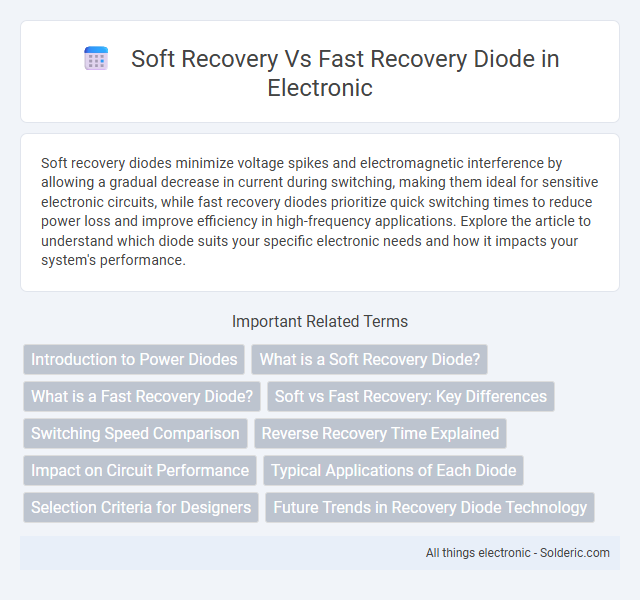Soft recovery diodes minimize voltage spikes and electromagnetic interference by allowing a gradual decrease in current during switching, making them ideal for sensitive electronic circuits, while fast recovery diodes prioritize quick switching times to reduce power loss and improve efficiency in high-frequency applications. Explore the article to understand which diode suits your specific electronic needs and how it impacts your system's performance.
Comparison Table
| Feature | Soft Recovery Diode | Fast Recovery Diode |
|---|---|---|
| Recovery Time | Longer recovery time, typically in microseconds (us) | Short recovery time, typically in nanoseconds (ns) to microseconds (us) |
| Reverse Recovery Current | Gradual decrease, reducing voltage spikes | Sharp decrease, possible higher voltage spikes |
| Applications | Switching power supplies, inductive load circuits, noise-sensitive applications | High-speed switching, power conversion circuits, PWM inverters |
| Switching Loss | Lower switching losses due to softer recovery | Higher switching losses, but faster operation |
| Electromagnetic Interference (EMI) | Reduced EMI due to smooth recovery curve | Higher EMI generation due to abrupt recovery |
| Typical Recovery Time Range | 0.5 us to 5 us | 50 ns to 500 ns |
| Cost | Generally higher due to specialized design | Typically lower cost |
Introduction to Power Diodes
Power diodes are essential semiconductor devices designed to control high voltage and current in power electronics, with Fast Recovery Diodes and Soft Recovery Diodes representing two key types distinguished by their switching characteristics. Fast Recovery Diodes feature minimal reverse recovery time, enabling efficient high-frequency switching but often causing voltage spikes and electromagnetic interference. Soft Recovery Diodes, on the other hand, exhibit a gradual recovery process that reduces voltage overshoot and noise, improving performance in applications requiring smooth switching transitions.
What is a Soft Recovery Diode?
A Soft Recovery Diode is designed to reduce voltage spikes and electromagnetic interference during the switching process by gradually transitioning from conducting to blocking state. This diode features a controlled reverse recovery characteristic that minimizes switching losses and improves efficiency in power electronic circuits. Commonly used in applications like power supplies and inverters, Soft Recovery Diodes are essential for enhancing reliability and performance in high-frequency switching environments.
What is a Fast Recovery Diode?
A Fast Recovery Diode is a semiconductor device designed to switch from conducting to blocking state rapidly, minimizing reverse recovery time and reducing energy loss in high-speed switching applications. Its quick recovery characteristic makes it ideal for power electronics, such as inverters, converters, and motor drives, where fast response enhances efficiency and performance. Understanding your circuit's switching frequency and loss requirements helps determine if a Fast Recovery Diode is the appropriate choice over a Soft Recovery Diode.
Soft vs Fast Recovery: Key Differences
Soft recovery diodes have a slower reverse recovery time, reducing electromagnetic interference (EMI) and voltage spikes during switching, while fast recovery diodes offer quicker switching speeds but generate higher noise. The key difference lies in the tail current behavior; soft recovery devices exhibit a gradual decay of current, minimizing stress on the circuit, whereas fast recovery diodes experience abrupt current changes. Your choice depends on the application requirements for EMI sensitivity and switching frequency.
Switching Speed Comparison
Soft recovery diodes exhibit slower switching speeds due to their controlled recovery tail, which minimizes voltage spikes and reduces electromagnetic interference. Fast recovery diodes switch more rapidly, enabling higher-frequency applications but can generate increased switching noise and voltage overshoot. The choice between soft and fast recovery diodes depends on the trade-off between switching speed and circuit stability in power electronics designs.
Reverse Recovery Time Explained
Reverse recovery time is the key difference between soft recovery and fast recovery diodes, defining how quickly a diode switches from conducting to blocking mode. Soft recovery diodes have a longer reverse recovery time, resulting in a gradual reduction of current that minimizes voltage spikes and electromagnetic interference, ideal for power supply applications. Fast recovery diodes feature a shorter reverse recovery time, allowing your circuits to operate at higher switching frequencies but may generate more noise, making them suitable for high-speed switching environments.
Impact on Circuit Performance
Soft recovery diodes reduce switching losses and minimize electromagnetic interference by allowing a gradual current decay during reverse recovery, enhancing circuit efficiency and reliability. Fast recovery diodes offer quicker reverse recovery times, improving switching speed but potentially causing higher voltage spikes and increased noise in sensitive circuits. Choosing the right diode impacts your circuit's performance by balancing speed, efficiency, and noise levels based on the application requirements.
Typical Applications of Each Diode
Soft recovery diodes are commonly used in applications such as power factor correction circuits, motor drives, and snubber circuits due to their ability to minimize switching losses and reduce electromagnetic interference. Fast recovery diodes are typically found in high-speed switching power supplies, inverters, and rectifiers where quick turn-off and high-frequency operation are crucial. Your choice between these diodes depends on the specific balance between switching speed and electrical noise tolerance required by your circuit.
Selection Criteria for Designers
Designers select soft recovery diodes for applications requiring low electromagnetic interference and reduced switching losses, particularly in high-frequency circuits like motor drives and power supplies. Fast recovery diodes are preferred when higher switching speeds and rapid response are essential, as seen in switching regulators and high-speed rectifiers. Key selection criteria include reverse recovery time, peak reverse recovery current, and the trade-off between efficiency and noise generation.
Future Trends in Recovery Diode Technology
Future trends in recovery diode technology emphasize enhancing efficiency and reducing switching losses by combining the advantages of soft recovery and fast recovery diodes. Innovations in materials like silicon carbide (SiC) and gallium nitride (GaN) enable superior thermal performance and faster switching speeds, catering to high-frequency power applications. Your choice of diode will increasingly benefit from advancements in integrated device design, improving overall reliability and energy efficiency in power electronics.
Soft Recovery vs Fast Recovery Diode Infographic

 solderic.com
solderic.com